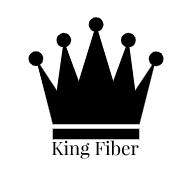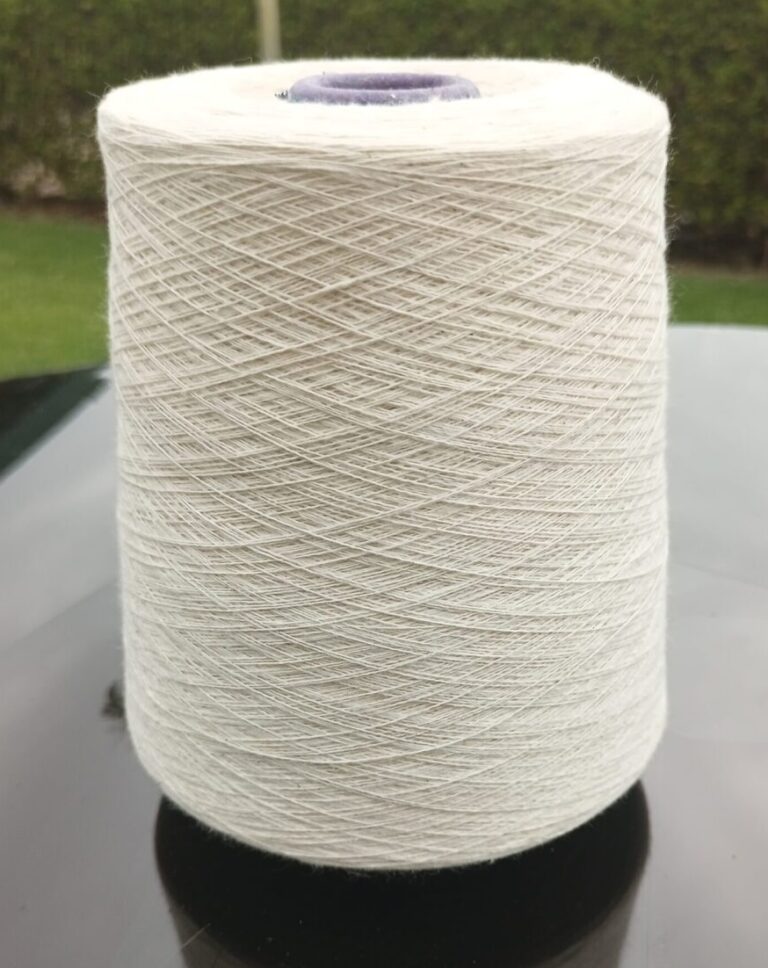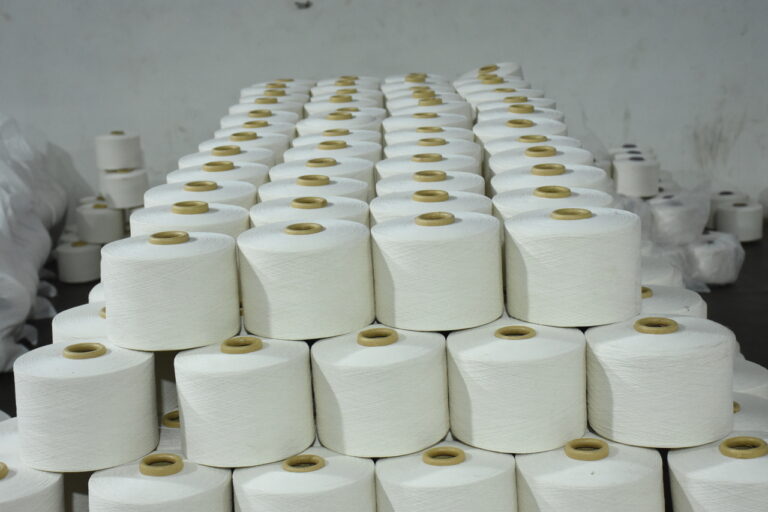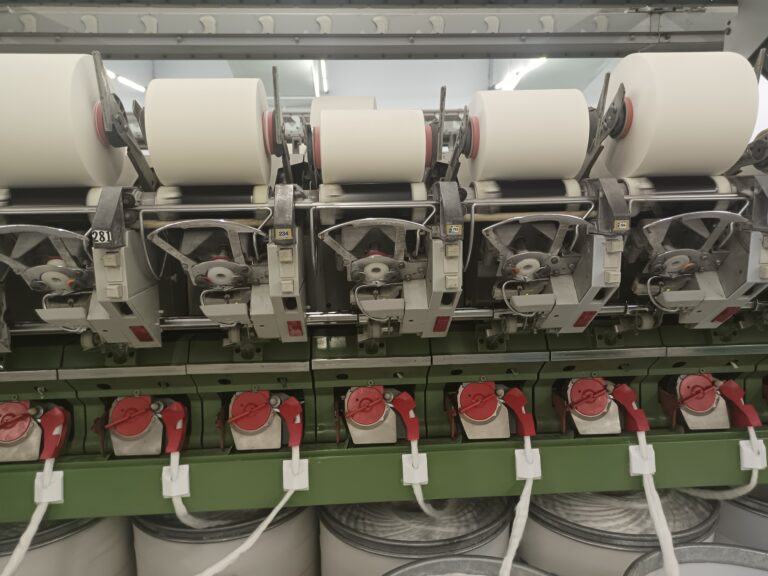
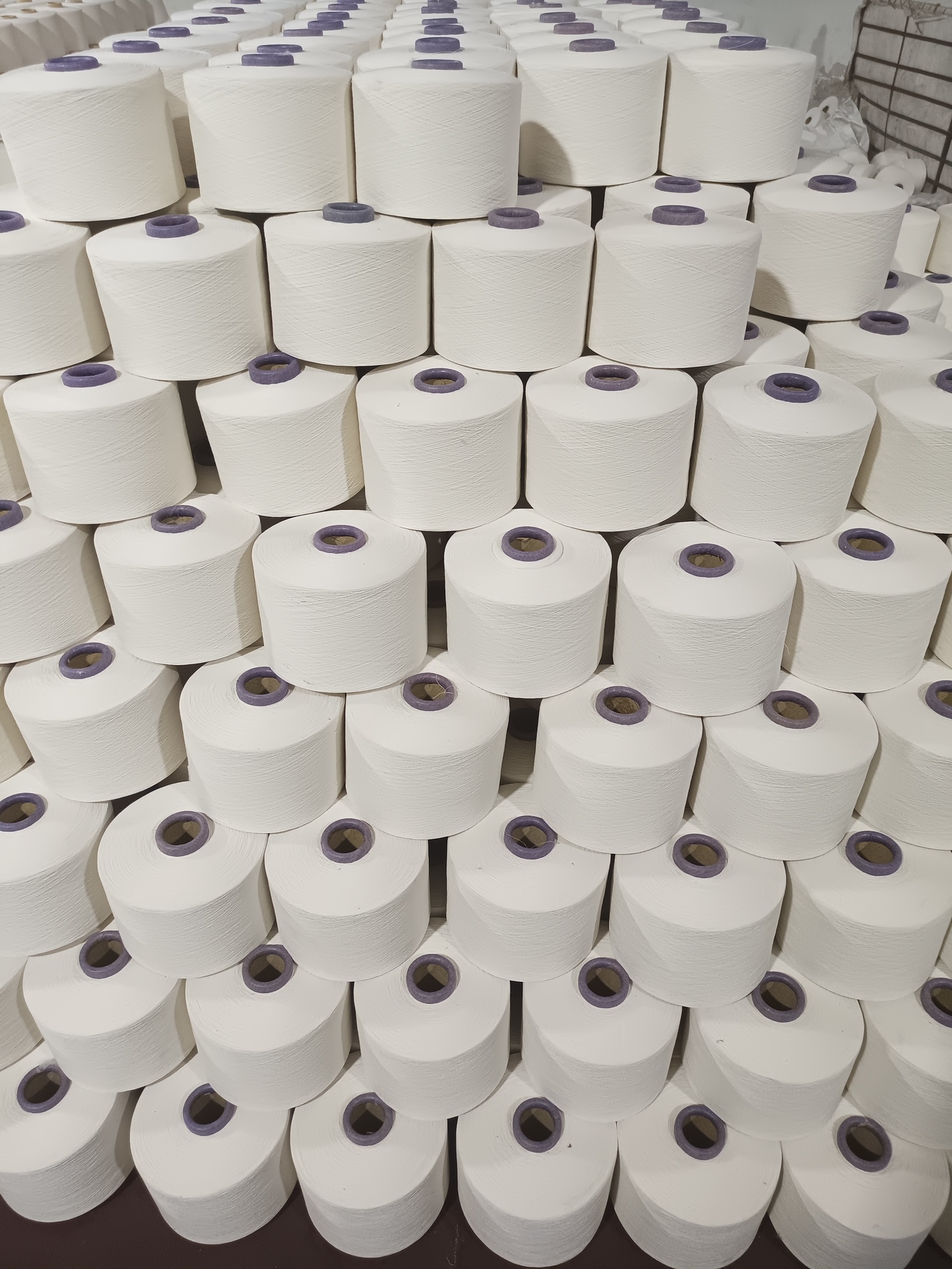
Product Information
- Project: Types Of Yarn
- Category: All types of yarn
- Clients: Alex Sam Martin
- Date: February 10, 2021
- Status: Completed
Different Types Of Yarn
Yarns can be classified into different categories. Again, you will get special types of yarns to find out all the types of yarns.
- Staple Yarn
- Filament Yarn
- Staple yarn
A staple-spun yarn is a linear assembly of fibers. Usually, the fibers are held together by the insertion of a twist, to form a continuous strand that is smaller in cross-section but of a particular specified length.
Fabrics are produced from yarns by different techniques like weaving, knitting, etc. Staple yarns can be subdivided into different categories based on their length, no. of ply, twist direction, spinning method, etc. We will discuss each of them below.
Staple-spun yarn can be classified into two categories according to its length:
- Short staple yarn: A staple fiber has a length of between 10 and 500mm. Short staple fiber has a maximum length of 60mm (cotton fiber is a short staple at about 25–45mm).
- Long staple yarn: Long staple fiber has a length of more than 60mm (wool fiber is a long staple at about 60–150mm).
-
According to twist direction:
- S twist yarn
If twisted in a clockwise direction, then the yarn is called S twist yarn. The inclination angle provides it with an English alphabetic S-like look.
- Z twist yarn
If twisted in an anti-clockwise direction, then the yarn is called Z twist yarn. The inclination angle provides it with an English alphabetic Z-like look.
- Zero twist yarn
By wrapping the soluble filament with untwisted staple fibers zero twist or twist-less yarn is produced. For wrapping purposes, hot water soluble filaments are required.
After weaving, these filaments are softened in hot water throughout processing. Thus twist less figure is achieved, therefore, it is called zero twist yarn.
The fibers are held together by adhesives, not by the twist, and are often laid over a continuous filament core.
- Filament yarn
Filament yarn is a collective form of twisted or without twisted strands of filaments. Here, each of the filaments runs the complete length of yarn. 50-100 filaments may be present in the multifilament.
Types of Yarns according to process sequences of manufacturing:
- Carded yarn
Carded yarns are produced from fibers that are only carded. These fibers are not combed. Carded yarn is spun in a ring spinning machine. They have dirt or seed coats too. Also, they have short staple fibers.
- Combed yarn
Both carding and combing processes are carried out for combed yarn. Normally it is manufactured by a ring spinning system. Beyond carding, combing is an additional process. Additional short fibers, trash, and neps are removed in this process.
Again, fibers are arranged in highly parallel order. This enables to production a high-quality yarn that has excellent strength and evenness. For good quality fine yarns, the combing process is actually carried out.
Types of Yarns according to the formation of yarn or system of twist insertion:
- Ring yarn
This is the most widely used method of staple-fiber yarn production. The fibers are twisted around each other to give strength to the yarn.
By ring spinning, machine ring spun yarn is formed. A combination of ring and traveler is used to insert a twist in the yarn. Ring yarns can be coarse or fine.
Opening, blending, carding, carding, drawing, simplex, ring spinning, etc processes are successively carried out for ring yarn.
Types Of Ring Yarn.
- Compact yarn
- Siro-spun yarn
- Rotor yarn
In rotor spinning, the machine rotor yarn is formed by the twisting of the rotor. Short fibers can also be used to produce this fiber. Rotor yarn is comparatively coarse. They are called open-end yarn also.
- Vortex yarn
Vortex is also an open-end yarn that is manufactured in a vortex spinning machine. The fineness of vortex yarn is coarse to medium fine.
- Air-jet yarn
Air jet yarn is a false twist or zero twist yarn. Like vortex and rotor yarn, air-jet is also an open-end yarn. Air-jet yarns are manufactured in an air-jet spinning machine.
Types of Yarns according to to use:
- Woven yarn
If the yarn is manufactured to produce woven cloth then it is called woven yarn. According to the direction woven yarn is categorized into two sub-sections like warp and weft.
The yarns of lengthwise direction are called warp yarns. Whereas if the yarns are used in the widthwise direction, they are called weft yarns. Warp yarns are stronger than wefts because they have to withstand the weaving tension.
Types of woven yarn:
- Warp
- Weft
- Knit yarn
The yarns produced for knitting purposes are called knitted yarns. They are soft and low twisted yarns.
Types of yarns according to no. of strand:
- Single yarn
Single yarns are made from a single filament or from a group of staple or filament fibers. The fibers are twisted together to form a desirable single yarn.
20s Ne, 30s Ne, 40/1 ne, etc are the example count of a single yarn. Single yarns cover monofilament, multifilament, and also spun yarns.
- Ply yarn
By twisting together two or more single yarns, ply yarns are made. Each part of the yarn is called a ply. Yarn can be two, three, or four plied. Sewing threads are ply yarns.
- Cord yarn
By twisting together plied yarns, cord yarns are produced. They are used for industrial purposes. They are seldom used in apparel.
Types of yarns according to fiber:
- Single fiber yarn
Single fibers are pure forms of fiber. There is no mixture of other fibers. The yarn is made up of 100% single fiber. For example 100% cotton, 100% polyester, 100% jute yarn, etc.
- Multi-fiber or blended yarn
Blended yarn is a mixture of two or more fibers. For example P/C, T/C, CVC, etc.
P/C or T/C: This is Polyester-Cotton or Terelyne-Cotton. Yarn that is produced by the mixture of polyester and cotton fibers is called T/C or P/C blend.
The maximum part of this yarn is the polyester part. The yarn has more than 50% polyester fiber. The rest part is cotton.
CVC (Chief Value Cotton): CVC is a blended yarn that has more percentage of cotton fiber compared to that the polyester part. For example Polyester: Cotton – 70:30 or Polyester: Cotton – 60:40
Special Types of Yarns
Novelty yarns
- Rarely used in entire apparel except in drapery applications
- Used for decorative purposes
- By a programmed difference in twist level or input rate in one or more components during the plying of the yarns, a novelty effect can be achieved.
This results in differential bending or wrapping between the components or in segments of buckled yarn that are permanently entangled in the composite yarn structure.
Types of novelty yarns:
- Fancy
- Metallic
- They may be of monofilament fibers or ply yarns.
- Two processes are commonly used to produce metallic yarns. The laminating process seals a layer of aluminum between two layers of acetate or polyester film, which is then cut into strips for yarns.
- The film may be transparent, so the aluminum foil shows through, or the film and/or the adhesive may be colored before the laminating process.
- The metalizing process vaporizes the aluminum at high pressure and deposits it on the polyester film.
Fancy yarns can be sub-divided into the below categories:
- Fancy yarns are formed by the irregular plying of staple fiber or continuous filaments.
- They are characterized by the presence of abrupt and periodic effects.
- The periodicity of these effects may be irregular or constant.
MARL YARN
- This is the simplest fancy yarn
- The yarns of two different colors are twisted together in a doubling process to yield marl yarn.
- The texture of marl yarn is different from normal double yarn.
- The marl yarn shows its primary effect by altering the color of its constituent yarns.
- The alteration shows a plain structure like an ordinary folded yarn.
- Discreet pinstripes in men’s suiting or subtly and irregularly patterned knitted fabric can be produced by marl yarns.
- The marl yarns may also be used in a Lurex or
- Along with metallic yarn, they provide great strength support, that can create a more subtle effect.
SPIRAL OR CORKSCREW YARN
- It is a plied yarn
- It exhibits the property of smooth spiraling of one yarn around the other.
- The yarn is straightforward
- The constituent two yarns have different lengths.
- It is very similar to the structure of a marl yarn.
GIMP YARN
- It is a compound yarn
- An effect yarn is wrapped around a twisted core to yield gimp yarn.
- This causes a wavy projection on the surface.
- The yarn is produced in two stages.
- A binder yarn is needed here to provide strength to the structure.
- Two yarns of the varied count are plied together.
- The plying of yarn should be of thick around thin, and again thin around thick to yield a gimp yarn.
- DIAMOND YARN
- Diamond yarn is produced by a coarse single yarn or roving folded with a fine yarn or filament. The finer yarn or filament should be of contrasting color
- To produce this yarn S-twist is used, which is cabled with a z-twisted fine yarn.
- A similar fine yarn using Z-twist is the cable with this S-twisted yarn. This technique can be extended and varied to produce multifold ‘cabled’ yarns with a wide range of effects.
- In the true diamond yarn, thin yarns may exert some compression up on the thick one.
-
- They includes staple or continuous-filament yarn
- The yarns may have ordinary extensibility but they have a remarkably high level of loftiness or fullness.
- These yarns preserve bulkiness in both relaxed and stressed situations.
- High covering power with lesser weight is possible in fabrics made of high-bulk yarns.It easily creates the subtle effects of color and texture. Particularly it is seen in relatively simple fabric structures.BOUCLE YARN
- At regular intervals, tight loops are seen projecting from the body of the yarns.
- Most of the boucle yarns are of three-ply construction whereas some of them can be produced by air-jet texturing. The three components are yarn core, effect yarn and the binder yarn.
- Firstly, the core yarn is wrapped around by the effect yarns. The wrapping is done in loops. Then, the binder is wrapped over the effect yarn so that the loops are held in their space.
- The individual plies may be filament or spun yarns. The properties of these yarns detect the final effect of this yarn.
LOOP YARN
- A core is wrapped around by an effect yarn to form a loop yarn.
- To create a nearly circular projection on the surface, it is being overfed.
- The following figure is simplified by showing the core as two straight bars. In reality, two yarns are twisted together to form a core entrapping the effect yarn.
- To constitute the loop yarn, four yarns are needed. Two of these form the core or ground yarns.
- Approximately, 200% overfed is given to form the effect yarn(s). These need to be of the accurate type and should posses great quality.
- To produce this yarn low twist and pliable yarn is required.
SNARL YARN
- Snarl yarn has a similar twisted core-to-loop structure
- Here ‘snarls’ or ‘twists’ are seen projecting from the core
- By using a high twist, lively and greater degree of overfeed as the effect yarn, snarl yarn is produced. It’s production method is similar to the loop yarn
- To achieve a snarl yarn of optimum size and frequency, spinning tension, overfeed detailing or even the degree of twist in the effect yarn may be controlled properly.
KNOP YARN
- Knop yarns have prominent bunches of one or more of its component threads
- The bunches are organised at regular or irregular intervals along the yarn’s length
SLUB YARN
- Thick places in the yarn are termed as slubs.
- In this yarn, effect of discontinuty slubs are intentionally created.
- At the thickest point of yarn, a slow change in thickening takes place.
- A slub may be three or four times the thickness of the base yarn
- Within a short length of yarn, this gradual thickening is observed.
FASCIATED YARN
- A series of wrapper fibers are used to tie up a core of parallel fibers to yield fasciated yarn
- fasiciated yarns are produced from staple fiber
- Air-jet yarns are structured in this way.
- More often the yarns that are formed by the hollow spindle method are also termed as fasciated yarn. This happens due to the binder which is applied to an essentially twistless core of parallel fibers.
TAPE YARN
- Tape yarn can be made by different processes. Braiding, weft knitting and warp knitting are practiced for producing tape yarn.
- In fashion knitwear, tape yarn earns much popularity.
- Narrow woven ribbons, narrow tapes of non-woven material, or slit film can be used in the similar way.
CHAINETTE YARN
- Chainette yarn can be created by using tiny circular weft knitting method.
- A ring of between 6 and 20 needles and a filament yarn is required to produce this yarn
- This method is popular for small scale production and now earns a great scope in fashion knitwear.
CHENILLE YARN
- To yield chenille yarn, woven leno fabric structure is slit into narrow and warp-wise strips.
- These are pile yarns
- A consistent pile height is seen throughout the length of the yarn
- To create yarn of irregular dimension, the constituent strips may vary in their length
- Chenille yarns are used in furnishings and apparel.
- This yarn requires intricate machinery. So, more often they are woven on a loom.
- In the chenille yarn, effect yarn is used to form a warp thread that is bound by weft.
RIBBON YARNS
- Ribbon yarns can’t be achieved by spinning
- As like the name, ribbon yarns are produced from finely knitted tubes while pressing flat to bear resemblance like tape or ribbon.
- Usually The ribbons has great softness, shine and silkiness.
COMPOSITE YARNS
- Composite yarns are also termed as compound yarns
- At least two threads are required to from composite yarn. One of these threads is used to constitute the core whereas the other constitutes the sheath component.
- One thread is a staple-fiber yarn and other a filament yarn.
- These yarns are even in diameter. They have smooth appearance and available in the same count range as spun and filament yarns.
COVERED YARNS
- They have a core completely covered by fiber or another yarn.
- May be the core made up of an elastomeric yarn. They could be rubber, spandex, polyester or nylon.
- Either a single or double covering is seen in covered yarn. The second covering is usually twisted in the opposite direction to the first.
Industrial yarns
- Industrial design requires special end-use yarns
- The yarns should have precise functional features. These yarns are engineered for performance under specified conditions.
- The industrial yarns do not have the optical and physical properties of yarns used for apparel and home-furnishing applications.
- Examples are tyre cord, asbestos and glass yarns, twine, rubber or elastic threads, core-spun yarns, wire yarn, sewing thread, heavy monofilaments, and split-film yarns
Types:
- Tyre cord
- Rubber or elastic core
- Multiply coated
High-bulk yarns
Stretch yarns
- Stretch yarns are preset textured yarns for high extensibility.
- Some can be stretched up to even three or four times their relaxed length but some can stretched up to once or twice of their relaxed length.
- These yarns are highly extensible and highly elastic.
- By texturizing thermoplastic continuous-filament yarns most of the stretch yarns are produced.
- This results in reasonably good nonlinearity or crimp in the individual filaments. The nonlinear structure of the filaments is heat-set but not entangled as in the case of the high-bulk yarns.
Types:
- Twist-heat set-untwist
- Crimp heat-set
- Stress under tension
- Knit-deknit
- Gear crimp
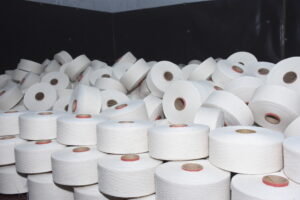
For Our Client’s
You won’t get confused in these so many types of yarns, that’s why all the types are described very easily in this article.
Fabric Treatment
Artistic Direction
Satin Weaving
Fabric Dyeing
Related Work

Knitting yarns require small twists and even yarns to ensure thick piles, good elasticity, and strong warmth retention of knitted sweaters. The yarn for weaving is required to be light, the weft yarn is less knotted, and the evenness.
The specification of cotton yarn mainly depends on what the cotton yarn is used for, so what are the common cotton yarns? Let’s take a look at the classification of cotton yarn!
We produce yarn according to our customer’s requirements.
